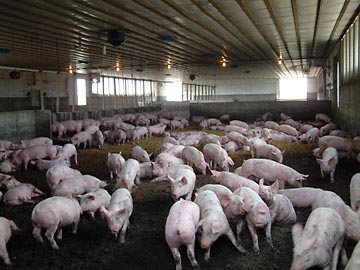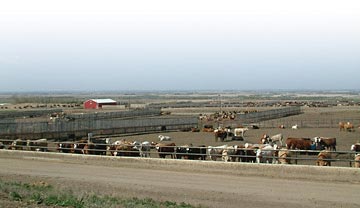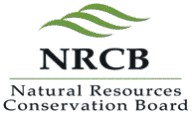| | What is a confined feeding operation (CFO)? | What if my CFO existed before January 1, 2002? | Do I need a permit to expand my CFO or manure storage facility? | What if I want to change a condition on my existing permit? | Is the NRCB only responsible for conditions on new permits? | What is the enforcement process for AOPA? | Can I make improvements to my existing CFO? | Can I change the type of livestock at my CFO? | Can I still expand my CFO if a new residence has been built nearby? | What manure handling regulations apply to my CFO?
The purpose of AOPA is to ensure that the province's livestock industry can grow to meet the opportunities presented by local and work markets in an environmentally sustainable manner.
In January 2002, the province established a permit process for confined feeding operations (CFOs) and set province-wide manure* management standards under the Agricultural Operation Practices Act (AOPA). The requirements under AOPA are aimed at supporting the sustainable growth of the livestock industry and protecting the environment.
On October 1, 2006, amendments to the regulations that support AOPA came into effect. The amendments provide further clarity to the original intent of the legislation, address permitting issues and update the standards for manure storage. Below are some frequently asked questions.
What is a Confined Feeding Operation (CFO)?
Confined feeding operations* (CFOs) are defined as fenced or enclosed land or buildings where livestock are confined for the purpose of growing, sustaining, finishing or breeding by means other than grazing, and any other building or ancillary structure directly related to that purpose. Grazing livestock operations, wintering sites, equestrian stables, auction markets, racetracks or exhibition grounds are not considered CFOs.
What if My CFO Existed Before January 1, 2002?
All CFOs or manure storage facilities that existed before January 1, 2002, are considered to have a permit under AOPA. Terms and conditions of permits issued by a municipality or health authority continue to apply and are enforced by the Natural Resources Conservation Board (NRCB). The type of permit an operation is considered to have is based on the type of livestock and manure storage and the existing CFO’s capacity as of January 1, 2002.For more information on the types of AOPA permits, refer to the contacts listed at the end of this publication.

Do I Need a Permit to Expand My CFO or Manure Storage Facility?
If a CFO does not have an existing permit then it is the capacity of the facilities (fenced or enclosed land or buildings) at the CFO as of January 1, 2002, that determines the number of animals that can be confined at the operation. Producers can continue to operate at the capacity of their operation until they expand their operation or alter their manure storage. Any expansion or alteration that increases the number of animals or amount of manure stored must be approved by the NRCB.
If a CFO with an existing permit has not yet constructed sufficient facilities to accommodate the number of animals stated in the permit and the conditions allowing the construction are still valid, then the facilities may still be built. However, the owner or operator is advised to contact the NRCB or an Alberta Agriculture CFO extension office before any construction.
What if I Want to Change a Condition on My Existing Permit?
Operators may apply to the NRCB to have amendments made to the terms and conditions listed on a permit issued by a municipality, local health authority or the NRCB. Applications for amendments may be subject to public input.
Is the NRCB Only Responsible for Conditions on New Permits?
The NRCB is responsible for compliance conditions on all existing municipal development permits and health authority permits, as well as the province-wide standards in AOPA for manure use, storage and handling. Producers with existing livestock operations must abide by the terms and conditions set out in any development permits issued by a municipality. However, producers can apply to the NRCB to have the conditions on their existing permit modified.

What is the Enforcement Process for AOPA?
NRCB inspectors use a risk-based approach for monitoring and inspecting operations to ensure regulations and permit conditions are met. An inspection of a livestock facility by the NRCB can be triggered if the NRCB receives a complaint. NRCB inspectors typically look at potential risks to the environment or problems related to the operation. If a problem is found, inspectors will work with operators to resolve the situation. When determining the appropriate enforcement response, inspectors will consider the significance of any non-compliance as well as the risk to the environment and the operator’s willingness to address the issue voluntarily.
Can I Make Improvements to My Existing CFO?
Producers are encouraged to improve their operations. Incremental improvements that reduce risks to the environment or reduce disturbance to neighbours can be made without having to fully meet all the standards and regulations within AOPA. For example, an operator who plans to increase the capacity of an existing manure storage facility from six months of storage to eight months must apply to the NRCB for a permit and may be issued a permit even though the change does not meet the nine-month requirement under AOPA.A permit under AOPA is required when producers are making changes to their manure and compost collection and storage facilities. If the changes are related to an increase in the annual production of manure and compost, the minimum distance separation (MDS) requirements may apply. If a producer is only making improvements to these facilities without increasing the annual production of manure or compost, the MDS requirements do not apply. Operators should contact the NRCB or an Alberta Agriculture CFO extension office before construction to verify what type of permit is required and if the MDS is applicable.
If an operator wants to replace or construct an ancillary structure such as an office, feed mill, machine shed, or other building integral to a CFO, the operator does not need a permit from the NRCB or municipality. However, the operator must notify the NRCB before beginning any construction, reconstruction or modification of the ancillary structure. Note: Municipal setback requirements (e.g. from roads) must also be followed.
Notify the NRCB before beginning any construction or modification of an ancillary structure.
The NRCB issues three kinds of permits. The type of permit depends on the nature of the activity and the number of animals, animal species and changes in the number of animals:
- Registrations are permits for smaller operations.
- Approvals are permits for larger operations.
- Authorizations are permits for manure storage facilities or manure collection areas.
Matters Regulation, Schedule 2
| Category of Livestock | Type of Livestock | Number of Animals (Registrations) | Number of Animals (Approvals) |
| Beef | Cows/finishers 900+lbs) | 150-349 | 350+ |
 | Feeders (450-900 lbs) | 200-499 | 500+ |
 | Feeder calves (<550 lbs) | 360-899 | 900+ |
| Dairy 1, 2 | Lactating cows3 (count lactating cows only - associated dries, heifers and calves are not counted) | 50-199 | 200+ |
| Swine | Farrow to finish4 | 30-249 | 250+ |
 | Farrow to wean4 | 50-999 | 1000+ |
 | Farrow only4 | 60-1249 | 1250+ |
 | Feeders/boars | 500-3299 | 3300+ |
 | Roasters | 500-5999 | 6000+ |
 | Weaners | 500-8999 | 9000+ |
| Poultry | Chicken-breeders | 1000-15999 | 16000+ |
 | Chicken-layer (includes associated pullets) | 5000-29999 | 30000+ |
 | Chicken-pullets/broilers | 2000-59999 | 60000+ |
 | Turkeys-toms/breeders | 1000-29999 | 30000+ |
 | Turkey-hens (light) | 1000-29999 | 30000+ |
 | Turkey-broiler | 1000-29999 | 30000+ |
 | Ducks | 1000-29999 | 30000+ |
 | Geese | 1000-29999 | 30000+ |
| Horses | Pregnant Mare Urine (PMU) | 100-399 | 400+ |
 | Feeders>750 lbs | 100-299 | 300+ |
 | Foals<750 lbs | 350-999 | 1000+ |
 | Mules | 100-299 | 300+ |
 | Donkeys | 150-449 | 500+ |
| Sheep | Ewes/rams | 300-1999 | 2000+ |
 | Ewes with lambs | 200-1999 | 2000+ |
 | Lambs | 1000-4999 | 5000+ |
 | Feeders | 500-2499 | 2500+ |
| Goats | Meat/milk | 200-1999 | 2000+ |
 | Nannies/billies | 400-2999 | 3000+ |
 | Feeders | 500-4999 | 5000+ |
| Bison | Bison | 150-349 | 350+ |
| Cervid | Elk | 150-399 | 400+ |
 | Deer | 200-999 | 1000+ |
| Wild Boar | Feeders | 100-299 | 300+ |
 | Sow (farrowing) | 50-99 | 100+ |
1 When dairy replacement heifers are housed away from the dairy, treat as Beef - feeders.
2 When dairy calves are housed away from the dairy, treat as Beef - feeder calves.
3 Dairy count includes lactating cows only.
4 Swine count includes sows only.
Can I Change the Type of Livestock at My CFO?
An operator must notify the NRCB before the change, but does not require a permit from the NRCB to change the type of animal (e.g. from feeders to weaners) within the same category (e.g. swine) as long as the total annual manure production does not increase. However, operators who want to change categories (e.g. dairy to swine) must obtain an amendment to their permit from the NRCB before making the change. Applicants should be aware that the municipality and neighbouring residents will be notified and can provide comments to the NRCB on the proposed amendment.
Can I Still Expand My CFO if a New Residence has been Built Nearby?
Owners and operators of CFOs can apply for permits to expand their operations if a residence was constructed within the minimum distance separation (MDS) after the CFO submitted an application for a permit or started construction. These residents are considered affected parties, and can submit comments and concerns about proposed expansions to the approval officer when they are officially notified that an application for a permit is under review.
What Manure Handling Regulations Apply to My CFO?
Anyone who produces, applies or transfers more than 500 tonnes of manure or compost per year must keep records and conduct soil tests every three years. Irrespective of the amount, anyone applying manure must also follow the soil nitrate-nitrogen and salinity limits, setback distances and manure incorporation requirements.
*Note: Terms used in this publication have been simplified to make it easier to read. Complete definitions are found in Section 1 of the legislation.
For example: the term manure includes the livestock excreta, straw, other bedding material, litter, soil, wash water and feed in the manure. Composted manure has the same requirements as manure.
For more information, contact: (Dial 310-0000 to be connected toll-free)
Alberta Agriculture and Forestry
Lethbridge: 403-381-5885
Red Deer: 403-755-1475
Morinville: 780-939-1218
Ag-Info Centre: 310 FARM (3276)
Publications: 1-800-292-5697
Natural Resources Conservation Board
Lethbridge: 403-381-5166
Red Deer: 403-340-5241
Morinville: 780-939-1212
Fairview: 780-835-7111
Response line: 1-866-383-6722

DISCLAIMER: This document is not intended as legal advice, but as an interpretive document to the Agricultural Operation Practices Act and Regulations.
Source: Agdex 096-2. Revised May 2007. |
|